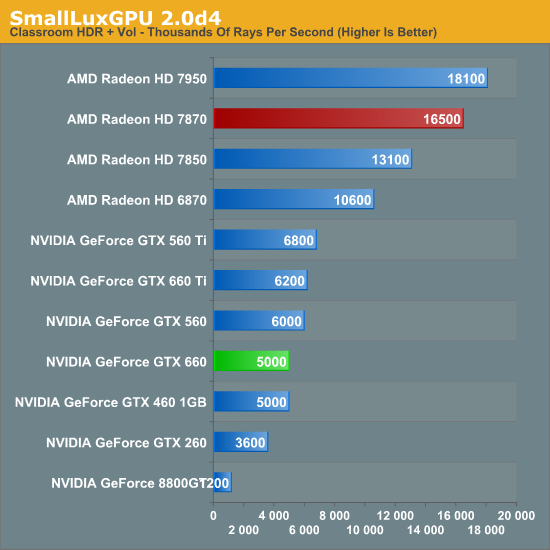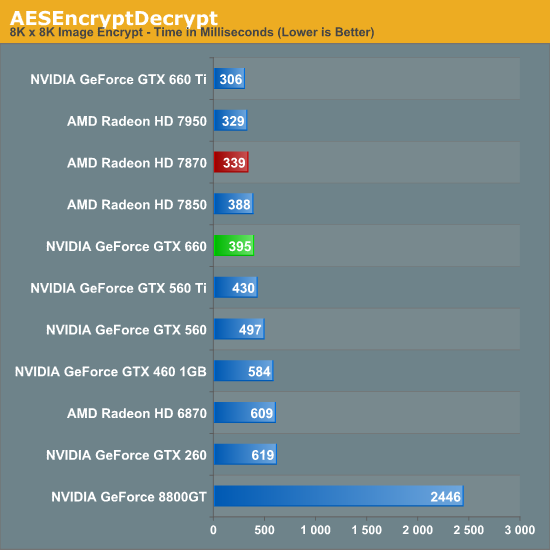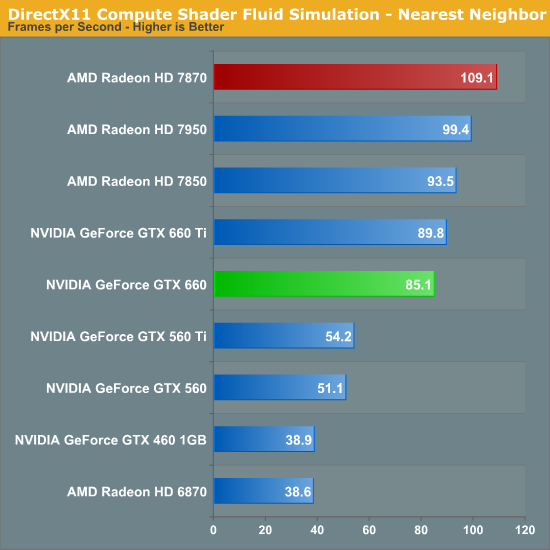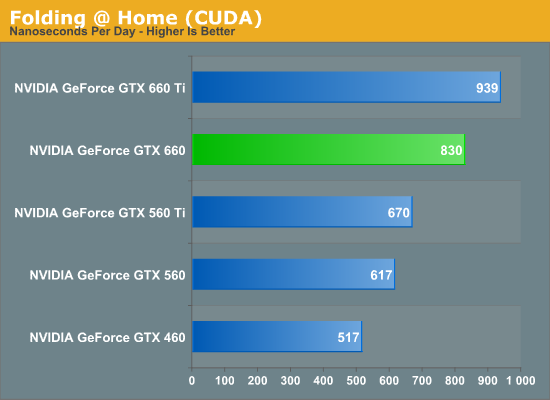The NVIDIA GeForce GTX 660 Review: GK106 Fills Out The Kepler Family
by Ryan Smith on September 13, 2012 9:00 AM ESTCompute Performance
As always our final set of real-world benchmarks is composed of a look at compute performance. As we have seen with GTX 680 and GTX 670, Kepler appears to be significantly less balanced between rendering and compute performance than GF110 or GF114 were, and as a result compute performance suffers. Further compounding this is the fact that GK106 only has 5 SMXes versus the 8 SMXes of GK104, which will likely further depress compute performance.
Our first compute benchmark comes from Civilization V, which uses DirectCompute to decompress textures on the fly. Civ V includes a sub-benchmark that exclusively tests the speed of their texture decompression algorithm by repeatedly decompressing the textures required for one of the game’s leader scenes. Note that this is a DX11 DirectCompute benchmark.

It’s interesting then that despite the obvious difference between the GTX 660 and GTX 660 Ti in theoretical compute performance, the GTX 660 actually beats the GTX 660 Ti here. Despite being a compute benchmark, Civlization V’s texture decompression benchmark is more sensitive to memory bandwidth and cache performance than it is shader performance, giving us the results we see above. Given the GTX 660 Ti’s poor showing in this benchmark this is a good thing for NVIDIA since this means they don’t fall any farther behind. Still, the GTX 660 is effectively tied with the 7850 and well behind the 7870.
Our next benchmark is SmallLuxGPU, the GPU ray tracing branch of the open source LuxRender renderer. We’re now using a development build from the version 2.0 branch, and we’ve moved on to a more complex scene that hopefully will provide a greater challenge to our GPUs.

SmallLuxGPU sees us shift towards an emphasis on pure compute performance, which of course is going to be GTX 660’s weak point here. Over 2 years after the launch of the GTX 460 and SLG performance has gone exactly nowhere, with the GTX 460 and GTX 660 turning in the same exact scores. Thank goodness the 8800GT is terrible at this benchmark, otherwise the GTX 660 would be in particularly bad shape.
It goes without saying that with the GTX 660’s poor compute performance here, the 7800 series is well in the lead. The 7870 more than trebles the GTX 660’s performance, an indisputable victory if there ever was one.
For our next benchmark we’re looking at AESEncryptDecrypt, an OpenCL AES encryption routine that AES encrypts/decrypts an 8K x 8K pixel square image file. The results of this benchmark are the average time to encrypt the image over a number of iterations of the AES cypher.

Our AES benchmark was one of the few compute benchmarks where the GTX 660 Ti had any kind of lead, but the significant loss of compute resources has erased that for the GTX 660. At 395ms it’s a hair slower than the 7850, never mind the 7870.
For our next benchmark we’re looking at AESEncryptDecrypt, an OpenCL AES encryption routine that AES encrypts/decrypts an 8K x 8K pixel square image file. The results of this benchmark are the average time to encrypt the image over a number of iterations of the AES cypher.

The fluid simulation is another benchmark that includes a stronger mix of memory bandwidth and cache rather than being purely dependent on compute resources. As a result the GTX 660 still trails the GTX 660 Ti, but by a great amount. Even so, the GTX 660 is no match for the 7800 series.
Finally, we’re adding one last benchmark to our compute run. NVIDIA and the Folding@Home group have sent over a benchmarkable version of the client with preliminary optimizations for Kepler. Folding@Home and similar initiatives are still one of the most popular consumer compute workloads, so it’s something NVIDIA wants their GPUs to do well at.

As we’ve seen previously with GK104, this is one of the few compute benchmarks that shows any kind of significant performance advantage for Little Kepler compared to Little Fermi. GTX 660 drops by 12% compared to GTX 660 Ti, but this is still good enough for a 60% performance advantage over GTX 460.










147 Comments
View All Comments
MySchizoBuddy - Friday, September 14, 2012 - link
If i'm a new buyer buying the older 560 at a reduced cost both be a better buy correct?Fiercé - Thursday, September 13, 2012 - link
While I may be in the minority, I actually check the "The Test" page of every GPU review in order to see which driver version is being used to test the hardware, as well as to get a quick mental list of 2 or 3 GPUs to watch out for in the FPS comparisons.Due to this I've noticed for this GPU review many cards are listed that don't appear anywhere in the benchmarks:
-AMD Radeon HD 6970
-AMD Radeon HD 7950B (explicitly stated over a non-B)
-AMD Radeon HD 7970
-NVIDIA GeForce GTX 570
-NVIDIA GeForce GTX 670
(Excepting all the GTX 660 Ti that of course can't be re-tested in time for a launch review, but might be useful as a "factory overclocked options" list for a reader looking at base 660 Ti performance.)
Ryan Smith - Thursday, September 13, 2012 - link
Thanks for the heads up. I had copied that out of the GTX 660 Ti article and had not yet edited it. It has been fixed.Fiercé - Thursday, September 13, 2012 - link
Cheers.Jamahl - Thursday, September 13, 2012 - link
That has the 660 faster than the 7870. Most reputable sites have the card squarely in-between the Pitcairns.Rick83 - Thursday, September 13, 2012 - link
It appears to me, that we should be glad, that the jump in performance is that low, as finally it seems the power wars of the last generation, when cards were dumping 200 Watts and more into your case, even when they were just higher mid-end cards, are over.Now of course that means we get slightly less of a performance boost, but at least power consumption of this card is below the level of a GTX260. That is important, as the 560Ti was relatively quite power hungry, especially once the wick on them was turned up a bit, which was being done quite liberally.
While the Performance/Dollar metric isn't that great, the performance/(dollar*power) is probably much better than last gen.
n9ntje - Thursday, September 13, 2012 - link
As everyone said it, nVidia is again late to the party. However, both (amd and nV) haven't done anything to improve the price/performance. First the $100 price range, now the 200?I'm sorry but since I bought my HD5750 almost 3 years(!) ago for 100 bucks. I dont get much more performance with a similair priced card. Now they are doing it the same to the 200 dollar cards..
CeriseCogburn - Thursday, November 29, 2012 - link
Welcome to the new socialist economy and 4 more years of it.Computer prices rise in the new socialist economy.
LOL
It's great, maybe AMD will get a bailout soon.
thorr2 - Thursday, September 13, 2012 - link
I saw the big image on the main page and thought it was a projector at first.cmdrdredd - Thursday, September 13, 2012 - link
Performance is not bad but the pricing is still too high. Start overclocking a 7870 and the 660 looks bad imo.